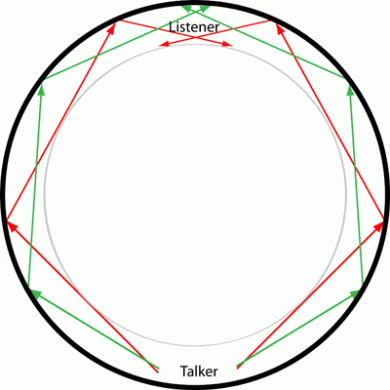Trevor Cox a lecturer at the university of salford has spent some time traveling the globe to discover the most interesting sounds that the world has to offer. His book ‘The sound book’ documents these weird and wonderful noises, here are a few that he has disused in interviews…
Whispering galleries are a strange acoustic phenomenon where sound is propagated over a curved surface, if a person is to talk into the wall at one side, the sound will travel on the surface and the opposite side will emanate the sound, and will sound as though the wall is whispering. Whispering galleries are generally not a planned aspect of the construction, and can occur in the most normal of places, for example the New York underground infrastructure, and St Pauls Cathedral in London, to name a few[1]. There are also purpose built whispering galleries for the enjoyment of the public for example there is a whispering gallery in the museum of science and industry in Chicago.

Figure 1 – How a whispering gallery works
Professor Cox (Trevor not Brian) also mentions a world record breaker… and that is for the longest reverberation in the world. Reverberation is measured using an impulse, in this case a shot was fired. The time it takes for the sound to decay by 60dB is measured. The location was an old oil storage site in Scotland, and remarkably the reverberation last for 112 seconds… … … … … Professor Cox remarked “My initial reaction was disbelief,” he said. “The reverberation times were just too long.” [2]

Figure 2 – A Long tunnel with a long reverb time
These are just two example of the sonic wonders found in our world, I hope this entices you to discover some unique sounds for yourselves. Also check out The Sound Blog for more interesting articles by Trevor Cox.
References:
[1] – http://www.npr.org/2014/02/10/274717997/sounds-intriguing-the-worlds-most-interesting-noises
[2] – http://www.bbc.co.uk/news/uk-scotland-highlands-islands-25757937






